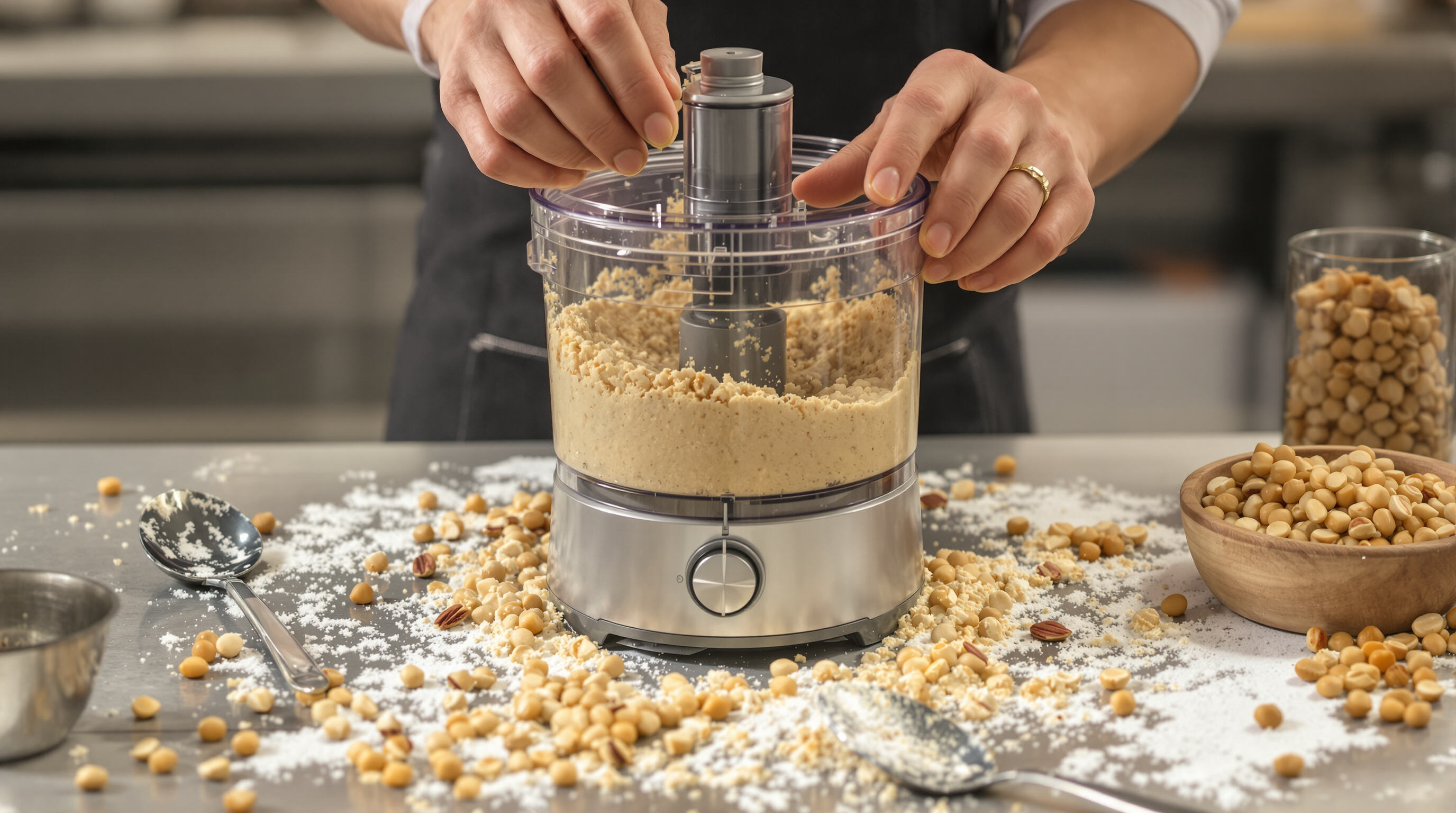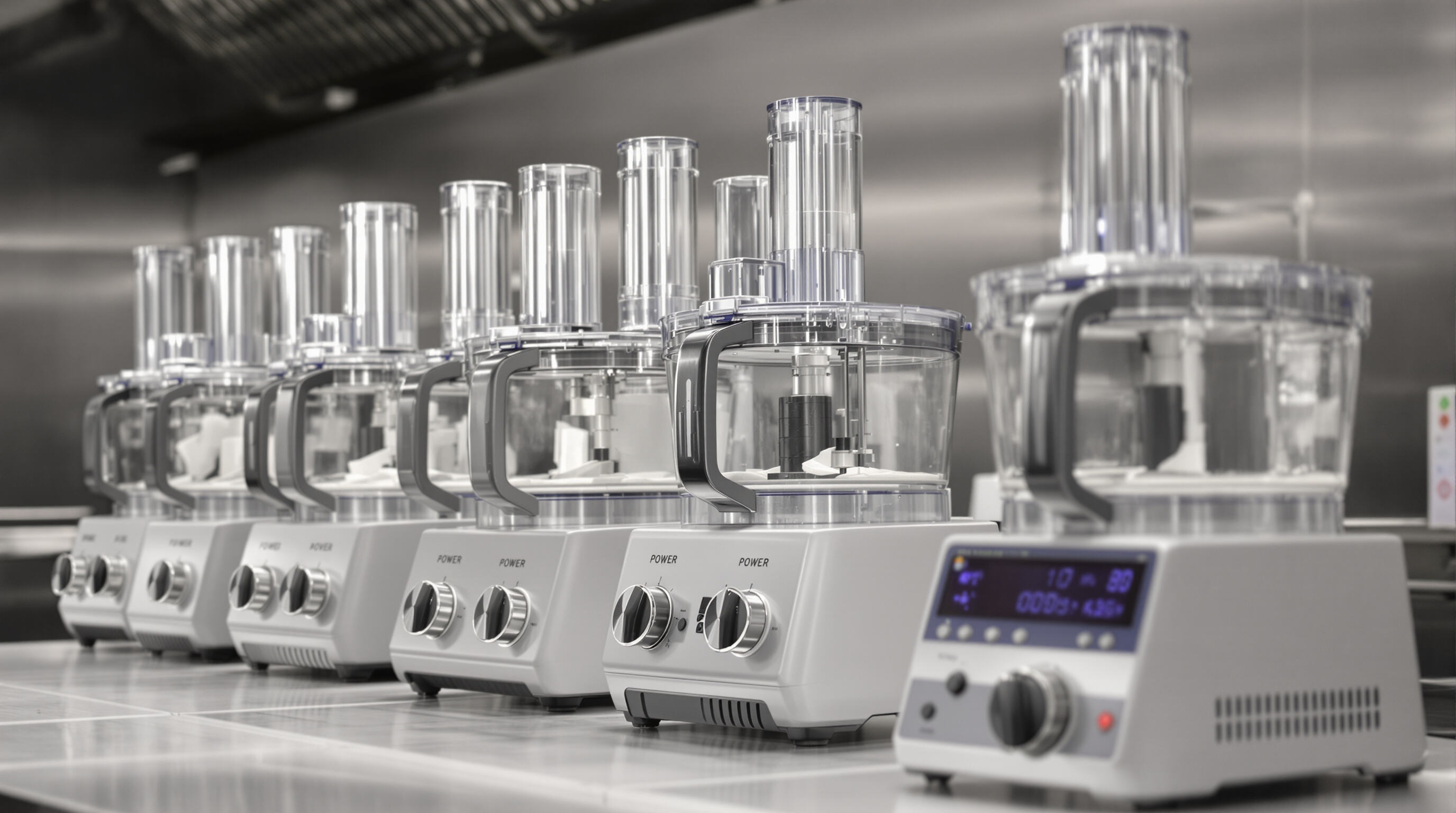News
High-Torque Food Processor Motors for Plant-Based Menu Expansion
Why High-Torque Food Processor Motors Are Essential for Plant-Based Kitchens
How High-Torque Motors Enable Efficient Processing of Fibrous and Dense Plant-Based Ingredients
Food processors with high torque motors really shine when tackling tough jobs like fibrous jackfruit or stubborn root vegetables such as cassava. These powerful motors produce around 30 to 50 percent more spinning power than regular models, so they can mash through those tough cellulose walls without getting stuck or melting down. The difference matters a lot for things like vegan meat substitutes and dairy free products too. When particles aren't all the same size, it just doesn't taste right and looks bad on store shelves. A friend who runs a small food business told me their customers could tell the difference between batches processed with different motor strengths.
Matching Motor Performance to the Unique Demands of Vegan Doughs, Nut Bases, and Legume Purées
When working with vegan doughs containing chickpea flour or those nut-based cheese alternatives, regular motors just don't cut it anymore. They need something special that can handle maximum torque even when running slow. The good news is high torque motor designs actually keep spinning at steady speeds despite all that weight pressing down on them. This prevents the dreaded motor burnout we've all seen happen with those super sticky legume batters getting stuck in equipment. For commercial kitchens making everything from gluten free breads to creamy nut butters day after day, this kind of dependable performance makes all the difference. After all, these types of products account for roughly two thirds of what most plant based restaurants prepare daily anyway.
The Rising Complexity of Plant-Based Menus Driving Innovation in Food Processor Motors
Plant-based menus aren't just about simple veggie burgers anymore these days. They've grown into something much more sophisticated with artisan cheeses and complex meat substitutes becoming mainstream. To keep up with this trend, food processors have gotten smarter too. The latest models come equipped with better heat control features that let them run longer without overheating, sometimes up to 40% more time than older versions. For busy kitchens dealing with delicate items such as soaked cashews throughout their daily routine of around 8 to 10 different preparation steps, this kind of reliability makes all the difference in maintaining consistent quality across multiple batches.
Core Applications: Dough Kneading and Plant-Based Ingredient Processing

Efficient Dough Kneading for Vegan Breads and Meat Alternatives Using High-Torque Motors
Food processors with high torque motors really shine when it comes to tough plant based doughs that regular machines just can't handle. According to research published in Nature last year, using mechanical kneading cuts down on those pesky air pockets in vegan dough by around 30% or so compared to mixing by hand. This makes a big difference for things like meat substitutes and gluten free bread where texture matters a lot. Look for motors that hit at least 450 RPM and have adjustable speeds too. These features let home cooks work with tricky ingredients like vital wheat gluten and pea protein isolate much better than standard models. The result? Dough that stretches and bounces back just like traditional wheat products without falling apart during baking.
Grinding Nuts, Seeds, and Fibers: Power Requirements for Consistent Plant-Based Textures
Processing fibrous ingredients requires motors capable of sustained 15â20 Nm torque. According to the Vegconomist Food Technology Report, 85% of commercial kitchens now prioritize food processors with overload protection when making nut-based cheeses or lentil patties. Key performance metrics include:
| Material Type | Optimal Motor Power | Processing Time Reduction |
|---|---|---|
| Raw Cashews | 1200W | 40% |
| Chickpeas | 1000W | 35% |
| Flax Fibers | 1500W | 52% |
Case Study: Vegan Bakery Boosts Output by 40% With High-Torque Food Processor Integration
A London plant-based bakery increased production by 40% after switching to 1500W food processor motors for simultaneous kneading and grinding. Staff reduced manual prep time by 11 hours weekly while maintaining 98% texture consistency across almond-flour pastries and seitan-based meat alternatives.
Maximizing Kitchen Efficiency with Multi-Functional Food Processor Use
From Sauces to Plant-Based Meats: Streamlining Diverse Prep Tasks in One Appliance
The latest high torque motors in food processors have changed how commercial kitchens handle plant based prep work, with some studies showing these machines can tackle around 83 percent of all necessary tasks right out of one box according to Restaurant India's 2024 report. What makes them so versatile? They switch effortlessly between making smooth cashew sauces and grinding various meat substitutes, adjusting blade speed anywhere from 800 to 12 thousand RPM depending on what needs processing next. Top end models come loaded with pre set functions too, which means they can simultaneously knead sticky lentil dough while cutting up veggies for fillings. Some kitchen staff reported cutting their preparation times down by roughly 35 percent during field tests last year, something that really adds up over time when running busy operations.
Reducing Labor and Prep Time Through Automated, High-Volume Processing
The high torque motors in these machines process food materials about 40 percent faster than regular models. Kitchens can now churn out 50 pound batches of nut cheese or TVP (textured vegetable protein) in just under eight minutes flat. The built in thermal protection lets these units run non stop throughout those long 12 hour kitchen shifts. This is pretty important given how plant based menus are growing at around 22% each year across the industry. Restaurants that switch to these combined units actually replace three different appliances altogether. That frees up roughly 18 square feet of valuable counter space while saving approximately $1,200 on electricity bills every single year.
Key Features Enabling Efficiency:
- Auto-sensing torque adjustment for switching between herb purées and root vegetable shredding
- Interchangeable blades that handle 97% of plant-based prep tasks without manual recalibration
- Cooling systems that maintain performance during 8+ hour operations
This consolidation allows staff to redirect 15 hours weekly from repetitive prep to recipe development and presentationâoffering a strategic edge in competitive plant-based dining.
Evaluating Motor Power: Key Metrics for Commercial Food Processor Selection

Understanding wattage, torque, and duty cycle in food processor motor performance
Commercial food processors typically fall somewhere between 370 and 2000 watts, which translates roughly to half a horsepower up to three horsepower. However, just looking at the wattage number won't tell the whole story about how well these machines actually perform. What really matters when it comes to crushing tough stuff like nuts or root vegetables is something called torque, measured in those Newton meters folks always mention. The motor needs enough twisting force to handle dense materials without bogging down. Another key factor worth considering is duty cycle. Most home models can't handle extended use because their motors tend to overheat after maybe 10 minutes of heavy work, especially when making things like seitan dough that requires constant kneading. For plant based kitchens where processing happens regularly throughout the day, finding a processor with sufficient torque maintenance capability becomes essential. Look for machines rated for continuous operation at least 30 minutes straight without significant drop off in power output.
High-torque vs. standard motors: performance comparison in plant-based kitchen environments
The high torque motors keep their speed steady even when dealing with tough stuff like fibrous veggies or pulse based doughs, something regular motors just can't handle without stalling out and messing up the texture. Think about trying to blend jackfruit or make cashew cheese base - these jobs require serious power, around 8 newton meters of rotational force to get things moving properly. Restaurants have noticed a big difference too, with commercial kitchens seeing about 40 percent fewer times they have to stop blending because the motor gives way during those stubborn legume batches. This kind of reliability makes all the difference when running a busy food operation where downtime costs money.
Debunking the myth: Are higher wattage motors always better for plant-based prep?
Just because something has higher watts doesn't mean it works better all the time. Take frozen coconut for example a regular 1000W motor might actually have trouble with it, but surprisingly enough, a smaller 750W motor with good torque can handle this job much better thanks to its gearing setup. Looking at energy usage data reveals something interesting too these big wattage motors that lack proper torque actually eat up around 30% more electricity when grinding nuts. And let's face it, when dealing with softer stuff like blending chia seeds or making vegetable purees, all that extra power just ends up costing more money at the end of the month without making anything taste any better.
Integrating High-Torque Food Processors into Commercial Kitchen Workflows
Optimizing Kitchen Layout and Workflow for Seamless Plant-Based Production
Positioning high-torque food processors strategically reduces bottlenecks in plant-based prep. A 2023 National Restaurant Association survey found kitchens with dedicated processing zones lowered prep times by 22% when handling fibrous vegetables and legume blends. Peak efficiency is achieved by:
- Placing processors near ingredient storage and washing stations
- Scheduling staggered processing for high-demand tasks like nut grinding
- Using modular countertops that accommodate multiple motor sizes
Leading equipment planners recommend 18&acir;24" clearance around units for safe bowl changes and maintenance, especially when processing dense plant-based meats.
Training Staff on Safe and Efficient Use of Food Processors for Repetitive Tasks
Proper training extends equipment lifespan by 30%, according to OSHA guidelines. Critical practices include:
- Correct blade assembly to prevent cross-threading during dough kneading
- Optimizing batch sizes for nut butters to avoid overheating
- Regular visual inspections for carbon brush wear during high-volume use
Kitchens using standardized checklists report 41% fewer service interruptions&acir;crucial when working with time-sensitive ingredients like soaked legumes or activated nut bases.
Balancing Upfront Investment with Long-Term ROI in Plant-Based Kitchen Equipment
Though high-torque processors carry a 15&acir;20% premium over standard models, their 8&acir;10 year service life in plant-based environments delivers strong ROI. A 2024 industry analysis found kitchens processing over 150 lbs/week of plant proteins break even within 18 months through:
- 35% reduction in labor for tasks like jackfruit shredding
- 60% lower replacement costs versus residential-grade units
- Energy savings from optimized duty cycles during continuous operation
Operators should prioritize warranty coverage for brushless motor components, which account for 73% of long-term maintenance costs in heavy-use plant-based kitchens.
Frequently Asked Questions
Why is torque important in a food processor motor?
Torque measures the twisting force that helps food processors handle dense ingredients like nuts and fibrous vegetables without bogging down. High torque motors provide consistent power, making them ideal for plant-based kitchens.
What are the benefits of high-torque food processors?
High-torque food processors offer faster and more efficient processing, reduce labor time, and enable tasks like dough kneading and grinding of nuts to be completed effortlessly. They also prevent motor burnout during extended use.
Are higher wattage motors always better for food preparation?
Not necessarily. While higher wattage motors provide more power, they may not always be efficient for specific tasks, especially if they lack proper torque. Sometimes smaller motors with good torque can handle certain jobs better, using less energy.
How does integrating high-torque food processors affect kitchen workflows?
Integrating high-torque food processors efficiently reduces bottlenecks, saves prep time, and enhances workflow. It allows kitchens to handle more tasks with fewer interruptions, providing strategic benefits in competitive plant-based dining.
 After-Sales:
After-Sales:
 EN
EN
 AR
AR
 HR
HR
 NL
NL
 FI
FI
 FR
FR
 DE
DE
 EL
EL
 HI
HI
 IT
IT
 PT
PT
 RO
RO
 RU
RU
 ES
ES
 TL
TL
 ID
ID
 SL
SL
 VI
VI
 ET
ET
 MT
MT
 TH
TH
 FA
FA
 AF
AF
 MS
MS
 IS
IS
 MK
MK
 HY
HY
 AZ
AZ
 KA
KA
 UR
UR
 BN
BN
 BS
BS
 KM
KM
 LO
LO
 LA
LA
 MN
MN
 NE
NE
 MY
MY
 UZ
UZ
 KU
KU









